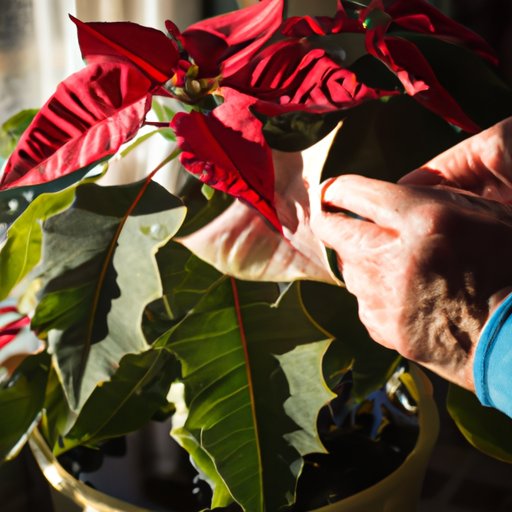Introduction
Poinsettias are a festive holiday favorite with their colorful foliage and cheerful blooms. This tropical shrub is native to Central America and requires special care in order to stay healthy and beautiful. With the right care, you can keep your poinsettia thriving year-round.
Provide Plenty of Sunlight
Poinsettias need plenty of bright, indirect sunlight to thrive. Place the plant near a window that gets at least six hours of sunlight each day. If possible, place the poinsettia in an east or west-facing window for the most direct sunlight. Keep the plant away from drafts and air conditioners, as these can dry out the foliage.
Direct sunlight can be beneficial, but it can also be damaging if the plant is exposed to too much. To avoid leaf scorching, gradually introduce the plant to direct light over a period of several weeks. Start by placing the poinsettia in a spot that receives morning sun and gradually move it into a brighter area.
Keep the Plant Watered
Poinsettias should be watered thoroughly when the soil feels dry to the touch. Allow the top inch of soil to dry out before watering, then water until the soil is saturated and excess water begins to drain from the pot. Empty any excess water from the saucer after watering.
In general, poinsettias should be watered once a week, although they may require more frequent watering in warmer weather. If the leaves start to wilt, this is a sign that the plant needs water. Avoid overwatering, as this can cause root rot.
Fertilize Monthly
Poinsettias benefit from regular fertilization. Use a balanced, water-soluble fertilizer formulated for flowering plants and follow the instructions on the package. To avoid burning the roots, dilute the fertilizer to half strength. Fertilize once a month during the growing season.
Stop fertilizing in late summer, as this can cause the plant to produce new growth too late in the season. This new growth will not have time to harden off and may be damaged by cold winter temperatures.
Prune the Leaves
To keep your poinsettia looking its best, pinch off the leaves that turn yellow or brown. These leaves are no longer functional and will detract from the overall appearance of the plant. Pinch off the leaves close to the stem and discard them.
Pruning the leaves will encourage the plant to produce new growth. This will help the poinsettia stay full and lush throughout the growing season.
Move to a Cooler Location
In late autumn, when the days become shorter and the nights cooler, move the poinsettia to a cooler spot in the house. The ideal temperature range for a poinsettia is between 60°F and 70°F. Temperatures outside of this range can cause the plant to drop its leaves prematurely.
When night temperatures dip below 50°F, move the poinsettia indoors. If you’re planning to keep the poinsettia outdoors during the summer months, make sure to bring it in before night temperatures drop below 50°F.
Conclusion
Poinsettias are a popular holiday choice, but they require special care to stay healthy and beautiful. Provide plenty of sunlight, water regularly, fertilize monthly, and prune off yellow or brown leaves. Move the plant to a cooler location in late autumn and keep it indoors when temperatures drop below 50°F.
By following these simple care tips, you can keep your poinsettia thriving all year round. For more information, check out the resources below.
Resources:
- National Gardening Association – Poinsettias
- University of Illinois Extension –


